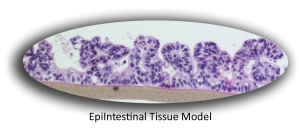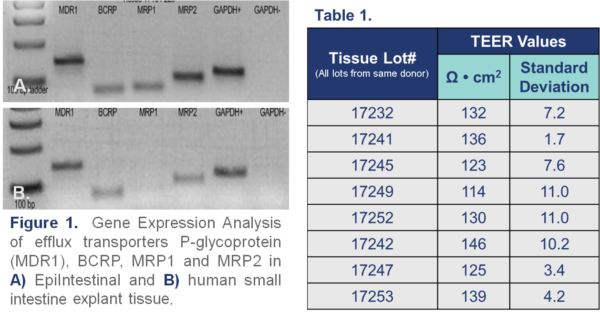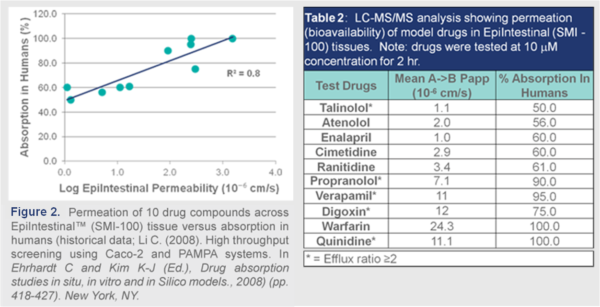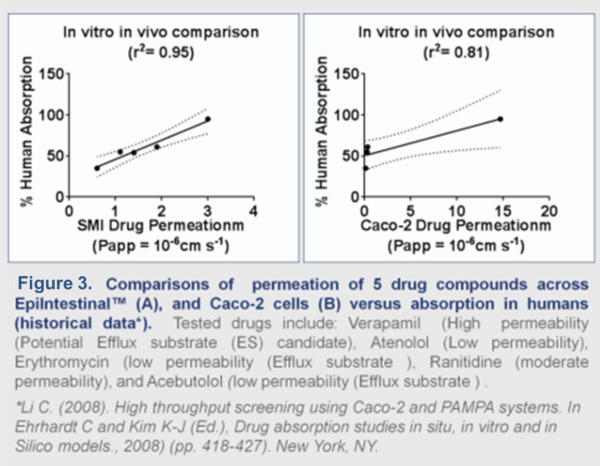Get the latest
Get MatTek offers and updates delivered to your inbox.
EpiIntestinal is a highly differentiated 3D tissue model that closely recapitulates the physiology, tissue structure, and function of the epithelium of the small intestine. Produced from normal human cells, EpiIntestinal is used in pharmaceutical development applications including the prediction of drug absorption and metabolism.
The EpiIntestinal tissue model is produced at the air-liquid-interface (ALI) in easy-to-handle tissue culture inserts and 96-well high-throughput screening plates. Characterization of the EpiIntestinal tissue model showed the presence of columnar shaped, proliferative basal cells (including LGR5+ Adult Stem Cells), Paneth Cells, M Cells and Enterocytes along with the expression and activity of efflux transporters. Structural analysis of EpiIntestinal confirms a polarized epithelium with villi structures and Kerckring folds. Ultrastructurally, EpiIntestinal exhibits brush borders, functional tight junctions and mucous secreting granules, similar to in vivo tissue.


Ultrastructural Analysis: Transmission electron micrograph (TEM) of A) in vitro EpiIntestinal and B) Explant tissue showing Brush borders (situated at the luminal pole of the enterocyte) and tight junctions. Brush border provides digestive and absorption surface; site for enzymes & transporters.

Characterization: Cross-sectional microscopic images of A) EpiIntestinal (epithelium only) labeled for CK19 (Red, epithelial cell marker) and Villin (Green, brush border marker) and B) EpiIntestinalFT (full thickness tissue containing fibroblasts) labeled for Vimentin (Green, fibroblast marker) and CK19 (Red).
EpiIntestinal was exposed to 10 model drugs that utilize specific drug transporters at 10µM concentrations for 2 hours. Drug uptake and efflux transport of test compounds were analyzed by LC-MS/MS. Tissue integrity and barrier function were monitored using transepithelial electrical resistance (TEER) and Lucifer Yellow leakage. The apparent permeability coefficient (Papp) was determined in the EpiIntestinal tissue model and compared to previously reported human absorption.
Analysis of EpiIntestinal revealed: 1) columnar epithelial cells expressing CK19 and villin, 2) expression of epithelial markers and efflux transporters (Figure 1), 3) highly reproducible and physiological TEER values of 110-150 Ω*cm2 (Table 1) and 4) brush borders. Studies using 10 model drugs showed a strong correlation (R2 = 0.8) in permeation of drugs across the EpiIntestinal tissue compared to historical values of absorption in humans (Figure 2, Table 2). EpiIntestinal demonstrated active drug transport (for drugs with efflux ratios >2 fold) which was significantly modulated by inhibitors of the efflux drug transporters (Table 3). Furthermore, when compared to historical values of absorption in humans, a stronger correlation was observed with EpiIntestinal (R2 = 0.95) than Caco-2 (R2 = 0.81) for low permeability drugs (Figure 3).




For more information, view the EpiIntestinal Technology Page, and Technical References.
Thank you for requesting information about MatTek products! A representative will contact you shortly.
**If you would like to place an order for MatTek products, please contact Customer Service**
Get MatTek offers and updates delivered to your inbox.